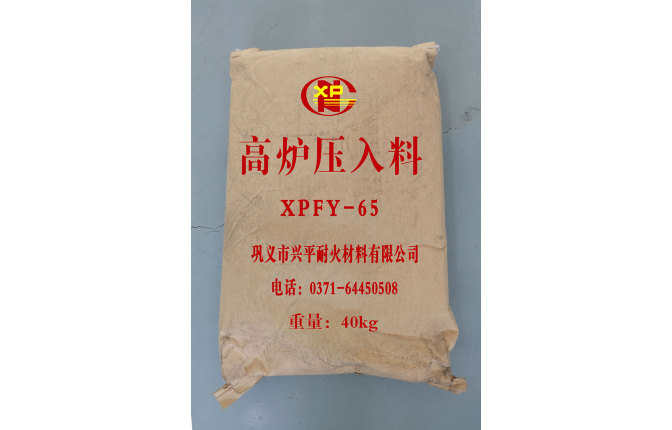高炉、热风炉修补用压入造衬料压入造衬法
高炉炉衬由于碱金属侵蚀、氧化铁侵蚀、热应力的破坏作用、热震的破坏作用,同时受到炉料磨损、含尘气流冲刷等机械力的作用以及其他特殊性质的破坏作用而不断损坏,并且高炉内衬损坏的特点是不均匀地被侵蚀,所以出现炉衬一部分尚好,而另一部分被严重损坏的现象。如果因局部损坏就进行中修或者大修,需要将原本尚好的砖衬全部拆除,而且费时费工,所以我公司的高炉压入造衬法可以很好地解决这些问题。
我公司的压入造衬法是在高炉不停炉的情况下,利用高炉的定期休风时间,保持高炉的热状态,在炉壳上钻孔或者利用现存孔使用压入设备将浆状耐火材料压入高炉炉墙内壁,使之固化、烧结与炉墙内侧炉衬或冷却壁牢牢黏结的一种炉衬修补工艺。此修补工艺可用在高炉和热风炉炉衬与炉壳的间隙、冷却壁与炉壳的间隙、高炉鼓风口与炉壳的间隙、出铁口和出渣口炉壳和耐火衬的间隙等等。通过压入造衬,可使炉衬磨损均匀,维持在一定的厚度,从而防止由于炉衬的损坏导致的炉壳、冷却设备受热变形或损坏、防止由于炉衬的损坏导致的砖砌体窜风,同时因为此技术工艺维修速度快,可快速恢复冶炼,延长高炉寿命,经济可靠,所以可作为高炉定期修补的技术方法,也可作为事故应急处理方法。
产品主要成分:
我公司压入法所使用的耐火材料主要以矾土、碳化硅、焦宝石、碳素为主原料,以酚醛树脂为结合剂,其主要化学成分是Al2O3、SiO2、SiC、C。其与水性结合的耐火材料相比具有一定的优势。水性结合压入料在修补时由于炉衬温度高,水分迅速蒸发,修补层容易发泡脱落,导致修补不致密,易剥落。我公司以酚醛树脂结合的压入料可以有效解决这个缺陷。特别是对于大型高炉,为了安全、高效、提高修补料的利用率,采用酚醛树脂做结合剂的压入料比采用水性结合材料更具有优势。
主要施工工艺:
1. 通过炉壳测温和打孔侧厚,选择炉壳发红处的周围或上部进行开孔
2. 在炉壳开孔处焊上压紧短管,安好球阀及快速管接头,然后用管道把开孔处和压入机联结起来
3. 用压入机将配置好的压入料通过高压压入进炉内,此时炉内的炉料起到挡板的作用,从内挤压压入料,使压入料可在炉衬和炉料间得以扩展,并迅速与炉衬黏结成一体。
4. 在炉温的作用下,压入料会很快硬化,修补了侵蚀脱落的内衬,在压入孔的周围形成了耐火保护层,堵塞了炉衬内气体的对流通道,维持了稳定的炉衬厚度,维护了高炉的正常生产,延长高炉寿命。
产品和技术优点:
1. 因采用树脂结合而非水系结合,该压入料产品性能和施工性能较水系结合压入料有很大程度的提升,更优越。
2. 压入造衬可根据休风时间定期对高炉损坏炉衬局部小面积修补,降低耐材消耗量,经济可靠,延长高炉寿命。
3. 压入造衬可根据高炉定期休风时间定期对高炉炉衬薄弱部位进行局部修补,是炉衬稳定在一定厚度,从而防止因炉衬大面积损坏导致专门休风或停炉,甚至造成事故,给钢厂造成重大经济损失。
4. 施工安全性高:因无需工作人员进入高炉工作,只需通过在炉壳上钻孔或者利用现存孔使用压入设备将浆状耐火材料压入高炉炉墙内壁,所以避免了工作人员发生煤气中毒、坠落、砸伤、碰伤等事故。
高炉压入料产品参数
项目 | 非水系 | 非水系 | 硬质 | 碳质 | |
牌号 | XPFY-55 | XPFY-65 | XPYY | XPTY | |
化学成分(%) | Al2O3 | ≥55 | ≥65 | ≥28 | - |
SiO2 | - | - | ≤45 | - | |
F.C | - | - | ≥25 | ≥55 | |
体积密度(g/cm3) | 110℃×24h | ≥2.2 | ≥2.7 | ≥1.8 | ≥1.7 |
显气孔率(%) | ≥23 | ≥25 | ≥21 | ≥24 | |
耐压强度(MPa)(1200℃×3h烧后) | ≥18.0 | ≥30 | ≥35 | ≥25 | |
抗折强度(MPa) | 110℃×24h | ≥4 | ≥10 | ≥16 | - |
1200℃×3h | ≥10 | ≥20 | ≥5 | - | |
线变化率(%) | 1400℃×3h | ≤±1 | ≤±0.8 | - | - |
耐火度(℃) | 1200℃×3h烧后 | ≥1700 | ≥1760 | ≥1790 | ≥1700 |
流动值(%) | - | 170-185 | 170-185 | - | 灰分≤5 |
粒度(%) | -1.5mm | 100 | 100 | - | 水分≤1 |
适用部位 | 炉体、冷却壁 | 炉体、风口 | 炉体 | 铁口、护缸 | |
备注 | 此技术参数仅是一种例子,非兴平耐材公司产品的保证值,我们会针对高炉的使用数据,研究其冶炼产物和操作方式、炉况予以调整,达到最好的使用效果. | ||||
热风炉压入料产品参数
项目 | 缓冲型 | 不收缩型 | 高强快干隔热型 | ||
牌号 | XPHY | XPBY | XPKGY-50 | XPKGY-55 | |
化学成分(%) | Al2O3 | ≥45 | - | ≥45 | ≥55 |
体积密度(g/cm3) | 110℃×24h | 0.8 | ≥1.8 | ≥1.5 | ≥1.8 |
耐压强度(MPa)(1200℃×3h烧后) | ≥5.0 | ≥20 | ≥10 | ≥15 | |
抗折强度(MPa) | 110℃×24h | - | - | ≥3 | ≥4 |
1200℃×3h | - | - | ≥5 | ≥10 | |
线变化率(%) | 1400℃×3h | ≥10 | 0-0.4 | - | - |
导热系数W/m.k | 0.2 | - | 0.5 | 0.2 | |
硬化时间min | 30-60 | - | 60-120 | 30-60 | |
适用部位 | 热风炉拱顶及热风炉保温层 | 高炉和热风炉底座灌浆 | 热风炉黏土砖大墙和热风炉管道 | 热风炉高铝砖大墙和热风炉管道保温层 | |
备注 | 此技术参数仅是一种例子,非兴平耐材公司产品的保证值,我们会针对高炉的使用数据,研究其冶炼产物和操作方式、炉况予以调整,达到最好的使用效果. | ||||

 18538276310
18538276310
 中文版
中文版 ENGLISH
ENGLISH
 Classify:
Classify: 2019-08-22
2019-08-22






